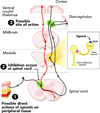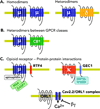Molecular mechanisms of opioid receptor-dependent signaling and behavior
- PMID: 22020140
- PMCID: PMC3698859
- DOI: 10.1097/ALN.0b013e318238bba6
Molecular mechanisms of opioid receptor-dependent signaling and behavior
Abstract
Opioid receptors have been targeted for the treatment of pain and related disorders for thousands of years and remain the most widely used analgesics in the clinic. Mu (μ), kappa (κ), and delta (δ) opioid receptors represent the originally classified receptor subtypes, with opioid receptor like-1 (ORL1) being the least characterized. All four receptors are G-protein coupled and activate inhibitory G proteins. These receptors form homo- and heterodimeric complexes and signal to kinase cascades and scaffold a variety of proteins.The authors discuss classic mechanisms and developments in understanding opioid tolerance and opioid receptor signaling and highlight advances in opioid molecular pharmacology, behavioral pharmacology, and human genetics. The authors put into context how opioid receptor signaling leads to the modulation of behavior with the potential for therapeutic intervention. Finally, the authors conclude there is a continued need for more translational work on opioid receptors in vivo.
Figures



References
-
- Dhawan BN, Cesselin F, Raghubir R, Reisine T, Bradley PB, Portoghese PS, Hamon M. International Union of Pharmacology. XII: Classification of receptors. Pharmacol. Rev. 1996;48:567–592. - PubMed
-
- Ahlbeck K. Opioids: A two-faced Janus. Curr Med Res Opin. 2011;27:439–448. - PubMed
-
- McNicol E, Horowicz-Mehler N, Fisk RA, Bennett K, Gialeli-Goudas M, Chew PW, Lau J, Carr D. Management of opioid side effects in cancer-related and chronic noncancer pain: A systematic review. J Pain. 2003;4:231–256. - PubMed
Publication types
MeSH terms
Substances
Grants and funding
LinkOut - more resources
Full Text Sources
Other Literature Sources
Medical
Research Materials

